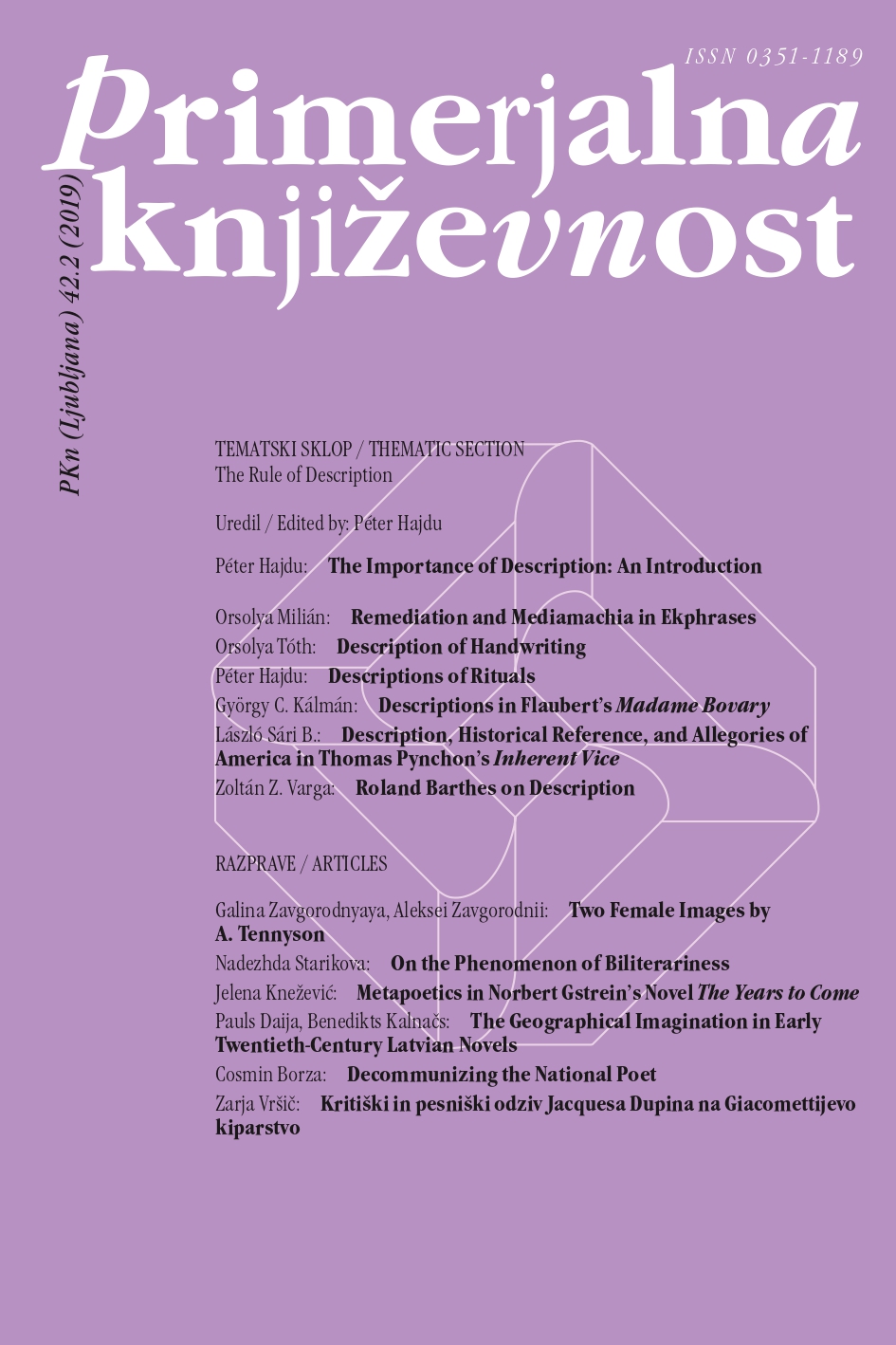Opis pisave: fiziognomski portreti v romanih devetnajstega stoletja
Ključne besede:
naratologija, roman, 19. stoletje, pripovedna tehnika, literarni liki, fiziognomija, pisava, opis, Lavater, Johann KasparPovzetek
Pričujoči prispevek se ukvarja s posebno vrsto opisa, namreč fizičnih potez literarnega lika in, širše, možnostmi opisa podobe (ekphrasis) v pripovedi. Najprej raziščem, kako se videz oseb – likov – odraža v romanu 19. stoletja. Nato preučujem sredstva in funkcije opisovanja pisave. Korporealna naratologija je nedavno izpostavila, da reprezentacijo človeških teles v pripovedi vedno določa dejstvo, da je podoba telesa zgodovinsko in kulturno konstituirana. V 19. stoletju je o ključnih prvinah tovrstnega kulturnega konteksta v svojih spisih o fiziognomiji pisal J. C. Lavater. Ob naslonitvi na terminologijo Graema Tytlerja v naratološkem jeziku rekonceptualiziram pojav postlavaterskega portreta.Literatura
Austen, Jane. Pride and Prejudice. London: R. Bentley, 1853.
Austen, Jane. Emma. London: R. Bentley, 1841.
Bacsó, Béla. “Phüszisz és Idea: Schiller korai műveihez.” Alföld 57.1 (2006): 57–66.
Bal, Mieke. “Description as Narration.” On Story-Telling. Essays in Narratology. Ed. David Jobling. Sonoma: Polebridge Press, 1991. 109–146.
Békés, Enikő. “Mutasd az orrod, s megmondom ki vagy, avagy miről írnak a fiziognómusok.” Ókor 2.2–3 (2003): 58–64.
Békés, Enikő. “Pál apostol fiziognómiája.” Természeted az arcodon. A fiziognómia története. Az ókortól a XVII. századig. Ed. Éva Vígh. Szeged: JATEPress, 2006. 381–414.
Belting, Hans. Faces. Eine Geschicte des Gesichts. Munich: C.H. Beck, 2013.
Berland, Kevin. “Inborn Character and Free Will in the History of Physiognomy.” Physiognomy in Profile. Lavater’s Impact on European Culture. Eds. Melissa Percival and Graeme Tytler. Newark: University of Delaware Press, 2005. 25–38.
Berthelot, Francis. Le corps du Héros. Pour une sémiotique de l’incarnation Romanesque. Paris: Nathan, 1997.
Brontë, Emily. Wuthering Heights. Ed. Beth Newman. Peterborough: Broadview Press, 2007.
Craig, Charlotte M. “A Rigid Issue: Lichtenberg versus Lavater.” Anthropology and the German Enlightenment. Perspectives on Humanity. Ed. Katherine M. Faull. Lewisburg: Bucknell University Press, 1995. 57–76.
Czifra, Mariann. “Érzelmek hálójában.” A Vörös postakocsi online. Web 22 January 2018.
Debreczeni, Attila. “Kazinczy, a dokumentátor.” Irodalomértelmezések a felvilágosodástól napjainkig. Ed. Egyed Emese. Kolozsvár: Egyetemi Műhely Kiadó, 2014. 281–289.
– – –. “Kazinczy emlékállító archívuma 1802–1803-ból.” Irodalomtörténeti Közlemények 118.2 (2014): 226–244.
Dickens, Charles. Great Expectations. Boston: Estes and Lauriat, 1881.
Erle, Sybille. Blake, Lavater and Physiognomy. New York: Routledge, 2010.
Eco, Umberto. “Az arc nyelvezte.” Fordította Kunkli Enikő. Magyar Lettre Internationale 53 (2004): 19–25.
Földes, Györgyi. “Jeltől a testig. A klasszikus narratológia találkozása a korporálissal.” Irodalomismeret 27.1 (2015): 5–29.
Goethe, Johann Wolfgang. Elective Affinities. Boston: D.W. Niles, 1872.
– – –. The Autobiography of Goethe. Truth and Poetry: From My Own Life. II. Ed. Parke Godwin. New York: Wiley and Putnam, 1849.
Graham, John. Lavater’s Essays on Physiognomy. Frankfurt am Main: Peter Lang, 1979.
Gray, Richard T. About Face. German Physiognomic Thought from Lavater to Auschwitz. Detroit: Wayne State University Press, 2004.
Gyimesi, Emese. “Szendrey Júlia versgyűjteménye a Magyar Tudományos Akadémia Kézirattárában.” Irodalomtörténeti Közlemények 116.1 (2012): 83–91.
Hamon, Philippe. “Qu’est-ce qu’une description?” Poétique 12 (1972): 465–485.
Jókai, Mór. Politikai divatok. I. Pest: Emich Gusztáv, 1862.
– – –. Egy magyar nabob. II. Budapest: Franklin-Társulat, 1875.
– – –. A tengerszemű hölgy. Budapest: Akadémiai, 1972.
Jósika, Miklós. Abafi. Tran. Zsuzsanna Tamás. Manassas: Payne Publishing, 2013.
Kazinczy, Ferenc. Kazinczy Ferenc Levelezése. Vols. 1–21. Ed. János Váczy. Budapest: Magyar Tudományos Akadémia, 1890–1911.
– – –. Pályám emlékezete. Ed. László Orbán. Debrecen: Debreceni Egyetemi Kiadó, 2009.
Kucserka, Zsófia. Könyvbe vésett jellemek. Szereplői karakter Kemény Zsigmondnál és a 19. századi magyar regényben. Budapest: Ráció, 2017.
Lavater, Johann Caspar. Essays on Physiognomy. Designed to Promote Knowledge and the Love of Mankind. To Which Are Added One Hundred Physiognomical Rules. Tran. Thomas Holcroft. London: Cowie, Low and Co., 1826.
– – –. Essays on Physiognomy. Tran. Thomas Holcraft. London: William Tegg and Co., 1878.
– – –. Pysiognomische Fragmente, zur Beförderung der Menschenkenntniß und Menschenliebe. Vol. III. Liepzig: Weidmann und Reich, 1777.
Lichtenberg, Georg Christoph. Schriften zum Physiognomik-Streit. Über Physiognomik wider die Physiognomen. Fragment von Schwänzen. Ed. Karl Riha. Giessen: Anabas-Verlag Kämpf, 1970.
Lombroso, Cesare. L’uomo delinquente. Turin: Bocca, 1889.
Mikes, Lajos and Dernői Kocsis, László. Szendrey Julia ismeretlen naplója, levelei és haláloságyán tett vallomása. Eds. Lajos Mikes and László Dernői Kocsis. Budapest: Genius, 1930.
Mitchell, W. J. Thomas. “Ekphrasis and the Other.” Picture Theory. Chicago: The University of Chicago Press, 1995. 151–208.
Moore, Evelyn K. “Goethe and Lavater. A Specular Friendship.” The Enlightened Eye. Goethe and Visual Culture. Eds. Evelyn K. Moore and Patricia Anne Simpson. Amsterdam: Rodopi, 2007. 165–193.
Percival, Melissa. The Apperance of Character. Physiognomy and Facial Expression in Eighteenth-Century France. London: W. S. Maney & Son, 1999.
Polcz, Alaine. Egész lényeddel. Pécs: Jelenkor, 2006.
Punday, Daniel. Narrative Bodies. Toward a corporeal narratology. New York: Palgrave Macmillan, 2003.
Stendhal. The Red and the Black. A Chronicle of the 19th Century. Tran. Horace B. Samuel. Auckland: Floating Press, 2014.
Stevenson, Robert Louis. “Strange Case of Doctor Jekyll and Mr. Hyde.” The Strange Case of Doctor Jekyll and Mr. Hyde and Other Stories. London: Collector’s Library, 2004.
Szauder, József. “A kassai Érzelmek iskolája.” A romantika útján. Budapest: Szépirodalmi, 1961. 90–114.
– – –. “Veteris vestigia flammae. Kazinczy szerelme.” Az estve és Az álom. Budapest: Szépirodalmi, 1970. 347–433.
Tóth, Orsolya. “Az arc olvasása? Fiziognómai szemlélet a 19. századi magyar irodalomban.” Bölcsész Akadémia 2. Eds. Böhm Gábor and Fedeles Tamás. Pécs: PTE, 2015. 27–45.
Tytler, Graeme. Physiognomy in the European Novel. Faces and Fortunes. Princeton: Princeton University Press, 1982.
– – –. “Physiognomy and the Treatment of Beauty in Jane Eyre.” Brontë Studies 41.4 (2016): 300–311.
– – –. “Physiognomy in Wuthering Heights.” Brontë Studies 21.4 (1994): 137–148.
– – –. “‘Faith in the Hand of Nature.’ Physiognomy in Sir Walter Scott Fiction.” Studies in Scottish Literature 33.1 (2004): 223–246.


